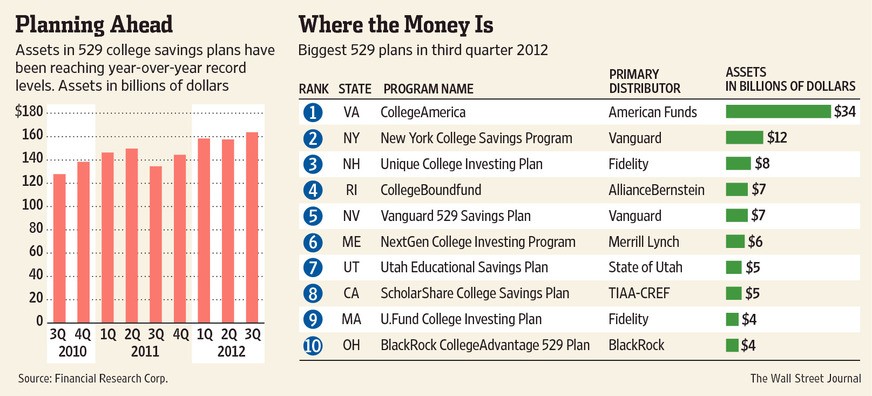529 Plan FAQsKiplinger
Post on: 11 Июль, 2015 No Comment

We’ve got answers to your frequently asked questions about 529 plans.
iStockphoto
Since Kiplinger’s first wrote about tax law changes concerning state-sponsored college-savings plans in 2001, readers have asked quite a few questions about how to pick the best plan, how to choose between a Coverdell Education Savings Account and a 529 plan and how to enroll.
SEE ALSO: 7 Smart Ways to Pay for College
This quick guide should help you understand the basics of 529 plans.
Is a state 529 plan the way to go?
Withdrawals for qualifying education expenses are tax-free. This tax-free status was set to expire in 2010, but Congress made the benefit permanent in 2006. Also, 529 plans are treated as parental assets when it comes to financial aid. (Parents are expected to kick in just 5.6% of their assets while students are expected to contribute 20%.)
Advertisement
Here are other reasons to consider a 529 plan:
They’re simple. State 529 plans are easy. Choose an investment option and make contributions and the plan does the rest. Sit back while the state or a third party, such as an investment firm, manages your funds.
Contributions may be state-tax deductible. Two-thirds of the states and the District of Columbia give a tax deduction or credit for contributions. Rules vary, so check with your state for more details. If your child skips college, you can make the recipient a sibling, grandchild, niece or nephew (or even yourself) without losing the tax break.
They’re portable. Depending on the state, you can choose from a number of different investing options. You also can switch investment tracks within the plan once a year. And if you don’t like your state’s plan, shop around. Plans are open to residents and nonresidents alike. You also can roll your savings into another state’s plan without penalty.
There are no nationwide annual contribution or income limits. Contribution limits vary by state, and some states do not limit contributions at all — a good option for grandparents looking to transfer assets through estate planning.
Don’t think of Coverdell ESAs and 529 plans as mutually exclusive. If you have the money, consider funding both. ESAs also can be spent on private school tuition or other qualified educational expenses.
Which state has the best plan?
If you live in a state that offers a deductible contribution, there’s probably no need to look further. Your savings on taxes likely will overcome any shortcomings your state’s 529 plan might have.
If you don’t get a deduction — or if you live in Arizona, Kansas, Maine, Missouri, Montana or Pennsylvania, which offer a tax break no matter where you invest — then consider these top picks:
What makes these state plans so good? Low expenses and plenty of investing options, two things you should focus on when making your choice.
Expenses. Annual fees, as well as management and maintenance expenses, can eat into returns and can vary greatly from state to state. If you choose to open your account through a broker, versus directly through the state, these fees and charges may be even higher. Also keep in mind that nonresidents typically pay higher fees than residents.
Also, keep in mind that you’ll pay income tax and a 10% penalty on the earnings on withdrawals not used to pay for education expenses.
Investment choices. Most states offer three or more investment tracks that range from conservative to aggressive. One usually is an age-based portfolio that invests mainly in stocks while a child is young then shifts to bonds and money-market funds the closer college is on the horizon.
When choosing a track, consider whether it reflects your risk tolerance. If you wouldn’t invest entirely in stocks in a retirement account, you probably shouldn’t do so for a college savings account, either.
How do I enroll?
This is the easy part. Enrollment can be as easy as downloading a form from the Internet, filling it out and mailing it in. Some plans actually let you open an account completely online.
Some plans allow you to open an account with as little as $25 or $50. And you can pay by check or set up monthly contributions through payroll deduction or automatic withdrawal from a designated bank account.
Can I roll savings bonds in to a 529 plan?

Yes, and there is no tax penalty.
Cash out the bonds and reinvest the money in the savings plan. At tax time you’ll want to file IRS Form 8815 to exclude the savings bond interest from income taxes. You also must make sure that the savings-bond rollover conforms to all the rules and that your income doesn’t exceed the limit. Visit the TreasuryDirect Web site for more details.
Can I transfer custodial account funds to a 529 plan?
Most 529 plans allow such a transfer, but there are a few special rules. Money you put into the kids’ custodial accounts was an irrevocable gift, and moving it to a 529 account doesn’t change that fact. The money can never be shifted to another beneficiary, for example, and your child will control it when they reach the age of majority, either 18 or 21, depending on state law. New money put into a separate account in the same 529 plan still can be controlled by the parents and shifted to another beneficiary if the child for whom the account is intended decides not to go to college.
The distinction between custodial-account money shifted to a 529 plan and other contributions is a good reason to separate accounts. College-savings plans accept only cash deposits, so you’ll have to sell the stock, mutual funds or other investments from the custodial account — and pay capital-gains taxes on any profits — to shift the money.
In most cases, it’s the child who gets the deduction when shifting custodial-account money into a 529. Remember: It’s the kid’s money. But a few states may allow parents to claim the write-off, says Joseph Hurley, author of The Best Way to Save for College: A Complete Guide to 529 Plans. For each state’s deductibility rules, visit Savingforcollege.com .
Can I split my contributions?
There’s no problem splitting your contributions among different states’ plans. But check the deductibility rules carefully. Some states let each spouse take an income-tax deduction for contributions, so you might double your deduction by opening up two accounts in your own state before moving on to another one. Your claim-the-deduction-then-move-the-money strategy might work, Hurley says, but some states recapture the tax savings. Again, you’ll have to check with the specific plan’s administrator.
Who controls the plan?
Each account has an owner — or joint owners — and that person controls the assets, regardless of how many people contribute. The owner doesn’t have to be a parent.
Can I switch plans?
You can move money as often as once a year for any reason. Contact the plan you’d like to switch into to get the forms you’ll need to make the transfer. Because many states continue to improve their plans, it’s smart to check out the options every year or so.
Can the money be used at a foreign college?
You can use the money at hundreds of foreign colleges, including the University of Toronto, McGill in Montreal and many other Canadian schools. If U.S. students at the school qualify for federal financial aid, you can use 529-plan money to pay the bills without worrying that you’ll lose any of the tax benefits.














